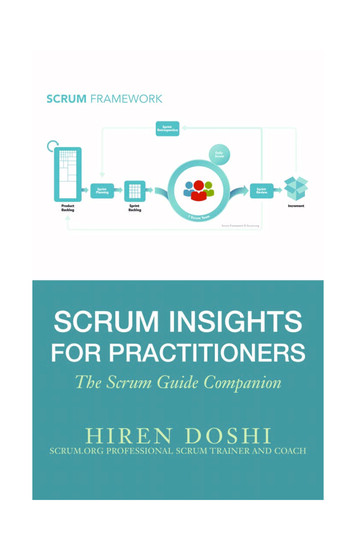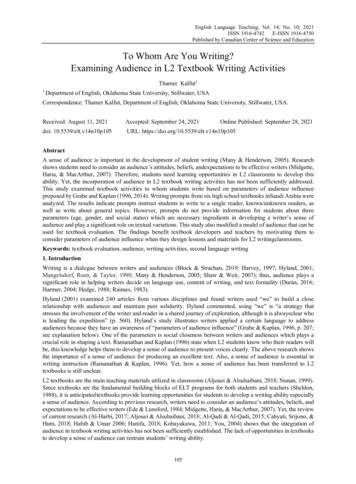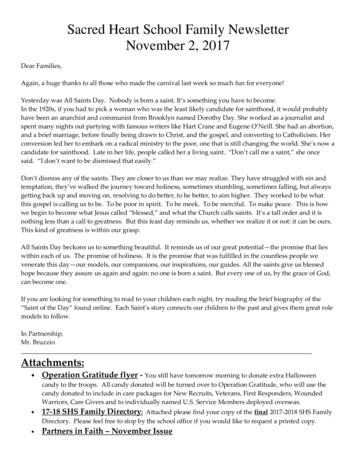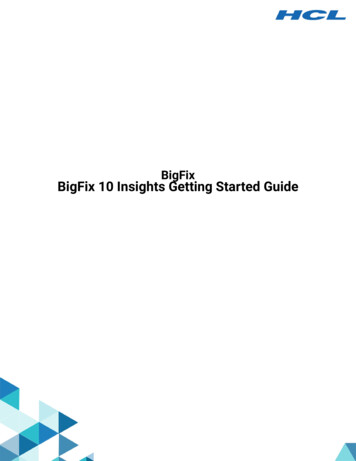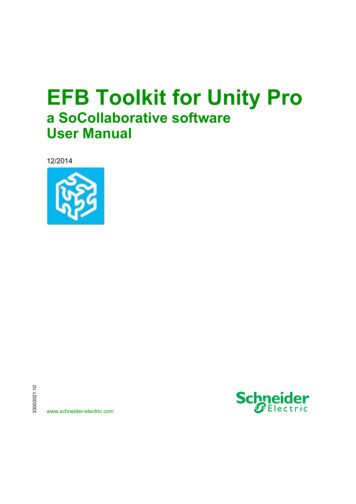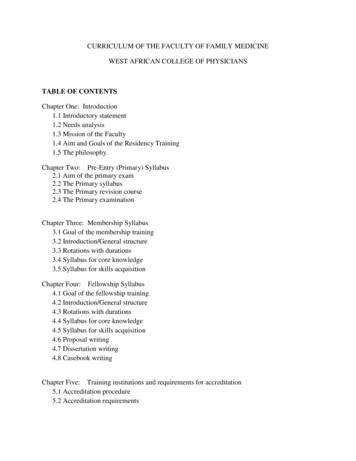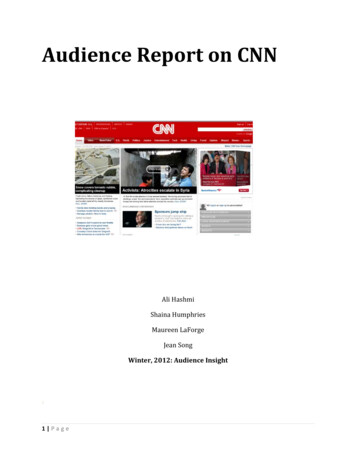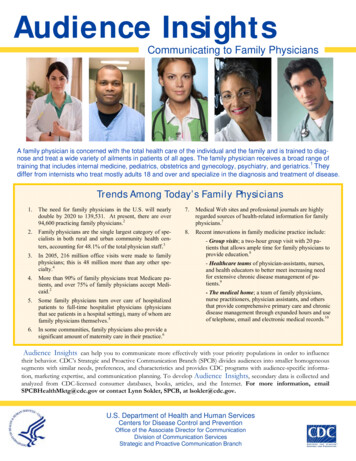
Transcription
Audience InsightsCommunicating to Family PhysiciansA family physician is concerned with the total health care of the individual and the family and is trained to diag nose and treat a wide variety of ailments in patients of all ages. The family physician receives a broad range of1training that includes internal medicine, pediatrics, obstetrics and gynecology, psychiatry, and geriatrics. Theydiffer from internists who treat mostly adults 18 and over and specialize in the diagnosis and treatment of disease.Trends Among Today’s Family Physicians1.The need for family physicians in the U.S. will nearlydouble by 2020 to 139,531. At present, there are over94,600 practicing family physicians.27.Medical Web sites and professional journals are highlyregarded sources of health-related information for familyphysicians.72.Family physicians are the single largest category of specialists in both rural and urban community health cen ters, accounting for 48.1% of the total physician staff.38.Recent innovations in family medicine practice include:3.In 2005, 216 million office visits were made to familyphysicians; this is 48 million more than any other specialty.44.More than 90% of family physicians treat Medicare patients, and over 75% of family physicians accept Medicaid.25.Some family physicians turn over care of hospitalizedpatients to full-time hospitalist physicians (physiciansthat see patients in a hospital setting), many of whom arefamily physicians themselves.56.In some communities, family physicians also provide asignificant amount of maternity care in their practice.6- Group visits; a two-hour group visit with 20 pa tients that allows ample time for family physicians toprovide education.8- Healthcare teams of physician-assistants, nurses,and health educators to better meet increasing needfor extensive chronic disease management of pa tients.9- The medical home; a team of family physicians,nurse practitioners, physician assistants, and othersthat provide comprehensive primary care and chronicdisease management through expanded hours and useof telephone, email and electronic medical records.10Audience Insights can help you to communicate more effectively with your priority populations in order to influencetheir behavior. CDC’s Strategic and Proactive Communication Branch (SPCB) divides audiences into smaller homogeneoussegments with similar needs, preferences, and characteristics and provides CDC programs with audience-specific information, marketing expertise, and communication planning. To develop Audience Insights, secondary data is collected andanalyzed from CDC-licensed consumer databases, books, articles, and the Internet. For more information, emailSPCBHealthMktg@cdc.gov or contact Lynn Sokler, SPCB, at lsokler@cdc.gov.U.S. Department of Health and Human ServicesCenters for Disease Control and PreventionOffice of the Associate Director for CommunicationDivision of Communication ServicesStrategic and Proactive Communication Branch
Family Physicians at-a-GlanceThese composites are for illustrative purposes only.“My patients frequently want thenewest high-techgizmo or pill they’veheard about or seenon TV. I stick to prescribing the mostappropriate medications for my patientsafter a thoroughwork-up and necessary diagnostictests.”William Ishizuka, M.D. (Rural group practice)Oxnard, CAAge: 38 Is in a busy three-person family practice group located in a ruralarea . Group also provides care in obstetrics and gynecology. 22% of patients are on Medicare, 12% receive Medicaid, 35% arein HMOs or IPAs, 22% have other health insurance, 9% have nohealth insurance. Relies on a network of 15 specialists for patient referrals. To re main certified, he completes many hours of continuing medicaleducation (CME) each year, mostly online. Cares for entire families. Many of his patients speak Japanese andare more comfortable visiting a physician who understands themand their culture.“Many of my olderpatients havechronic health condi tions and see me ona routine basis. Mypractice is growing.I’ve moved to elec tronic medical re cords and computerassisted patient datasystems that allowmy patients to up date their conditionselectronically atevery visit.”Phyllis Epps, M.D. (Inner city group practice)Philadelphia, PAAge: 55 Completed a residency in gastroenterology medicine at UCLA inSanta Monica, CA, but wanted to practice medicine for the “wholepatient”. Frequently goes to CMEweb.com, eMedicine.com or her medicalschool’s Web site for grand rounds and lectures by way of videoon the Internet. Is in a group practice with five other family physicians and nursepractitioners. Is promoting group visits with 20 diabetic patients at a time; fo cuses on nutrition, exercise, and compliance with medication use.“I’m an early adopterof technology anduse my BlackBerry and Epocrates Rx tocheck on drug infor mation, includingpossible side effects.It’s hard to keep upwith everything but Iwant to incorporatethe latest, most ef fective medical andtechnologically ad vanced practices.”Patrick Austin, M.D. (Small group practice in rural city)Jackson, MississippiAge: 64 Has been in a solo family practice for 32 years in the same officelocation; treats several multi-generational families. Uses a BlackBerry to log patient information and receives radio logical images from the local hospital on it as well. His medical office is located near the hospital he uses when hispatients require in-hospital treatment. Spends more than 15% of his time caring for children. Is contemplating retirement in 5 years. He and his wife plan toretire in Phoenix, Arizona.2AUDIENCE INSIGHTS: FAMILY PHYSICIANSSTRATEGIC AND PROACTIVE COMMUNICATION BRANCH
Health-Related Information Sources Usedby Family PhysiciansTargeted HealthCommunicationKnowing the habits and preferences of Family Physicianscan help you plan health communication and marketing effortsfor this audience. Medical Web sites and journals are highly regarded assources of health-related information for family physicians. Online physician communities are becoming more of aresource to discuss patient care and solicit feedback. Con sider banner advertising on such online communities as the6000-physician-member community Web site Sermo,www.sermo.com†, as well as WebMD’s recently launchedMedscape Physician Connect, www.medscape.com/connect†. However, 75% of family physicians often orregularly obtain health-related information from other phy sicians and also consider CDC a reliable informationsource. Specialty-aligned professional medical groups and theirWeb sites, such as the American College of Physicians †Internists - Doctors for Adultssm can be utilized to reachthis audience. As young doctors come into family practice, the onlinetools they access will be increasingly good ways to reachthem. Sixty-two percent of family physicians never or rarelyview medical podcasts.7 Many family physician practices rely on nurses or prac tice managers to download and post information in theiroffices. This should be considered in any materials dis semination strategy. Remember, all physicians today have very limited time,so don’t make them read through heavy text documents.Make it easy for them to get your information quicklyalong with your call-to-action (i.e., what you are askingthem to do).Family physicians use the following sources “often” or“regularly” to obtain health-related information:SourceOften or RegularlyMedical journals82%Other physicians75%Medical Web sites70%Government agencies48%Books47%Medical podcastsSOURCE: Porter Novelli’s DocStyles, 200815%7Family physicians most frequently use journals (93%), Inter net sites (87%), and conferences (85%) to pursue their con tinuing medical education.7Family Medicine Practices in the U.S.Types of family medicine practices:6 69.8% are group practices18.4% are individual practices11.8% are hospital or clinic-based practices Sixty percent of family physicians care for newborns, and20% of visits are with children.11 Primary care includes health promotion, disease preven tion, health maintenance, counseling, patient education,diagnosis and treatment of acute and chronic illnesses in avariety of health care settings (e.g., office, inpatient, criti cal care, long-term care, home care, etc.).123SOURCE: CDC - Advance Data from Vital and Health Statistics.Send your feedback or questions to SPCBHealthMktg@cdc.gov13AUDIENCE INSIGHTS: FAMILY PHYSICIANS
Facts about Family Physicians Family physicians receive extensive training in thecare of infants, children, and adolescents since theseare key patients in their practice.14 One in four of all office visits are made to familyphysicians.15 The average income of family physicians in 2006was 161,000.16Number of Family Physicians by spanic4,5172,8601,711Asian7,6184,1513,467American Indian/Alaskan 324Total82,86654,45028,416SOURCE: American Medical Association, Physician Characteristics andDistribution in the US, 2008 Edition (Chicago: AMA Press, 2008) 17More on Today’s Family Physicians A recent survey by Medical Economics magazine indi cates family physicians generally spend between 50 and55 hours a week caring for patients and managing theirpractice.19 Family physicians work, on average, three hours fewerper week than internists; two hours fewer than orthope dic surgeons, and 10 hours fewer than cardiologists, gas troenterologists, general surgeons, and obstetricians.19 Diversity in the physician workforce is essential forhigh-quality medical education and access to healthcare for the underserved.18 White males make up the majority race/ethnicity offamily physicians (39%), followed by white females(19%).18 There are more black female family physicians thanmale, with the reverse being true for Hispanic familyphysicians.18 Also, there are more Asian family phy sicians than either Hispanic or black. More than 80% of family physicians choose to havehospital privileges.6 Nearly one-fourth of family physicians have reportedworking part-time at some point in their careers to ac commodate personal and professional needs.19 Typical work breakdown for family physicians:20 4AUDIENCE INSIGHTS: FAMILY PHYSICIANS 40 hours per week in direct patient care An additional 10 hours, or 50 hours to tal, per week in patient-related activities 47 weeks - Average number of weeksworked in one yearFamily physicians typically schedule five weeks peryear for vacation or continuing medical educationcourses.20STRATEGIC AND PROACTIVE COMMUNICATION BRANCH
Electronic Media Use by FamilyPhysicians, Including Web 2.0 96.9% own or use high speed Internet in their office.7 69% own or use a Personal Digital Assistant (PDA).7 14% of family physicians report using a mobile device suchas a BlackBerry .21 Nearly a third of medical schools are now requiring newstudents to have a PDA.21Attitudes/Opinions of Family Physicianson Health-Related Information Providedby PatientsThe majority of family physicians are appreciative of patients pro viding them with health-related information. Market research con ducted with family physicians indicates: 87.4% strongly agree or agree that their patients com monly tell them about health-related information theyhave read, seen, or heard in the news.7 The majority of family physicians value (66.8%) or trulyappreciate (67.3%) health-related information provided bypatients and/or their parents.7Physician ShortageEstimates suggest that by 2020 the U.S. healthcare system will be40,000 doctors short of where it needs to be in the primary carearena to support the demand for medical care. Experts believe thatthe primary reason for this shortage is the payment structure. Aspecialist can earn 500K a year or more and work 20 hours aweek, while a family doctor will make closer to 150K and work60 hours a week. Incentives are changing in order to recruit moremedical students into primary care, but if the situation is not fixedit will cause an even greater strain on these already overburdenedclinicians.225Send your feedback or questions to SPCBHealthMktg@cdc.govAUDIENCE INSIGHTS: FAMILY PHYSICIANS
References1. American Medical Association. “Choosing a specialty”Copyright 1995-2009 American Medical Association.Available at: becoming-physician/choosing specialty.shtml10. American Academy of Family Physicians. Patientcentered Medical Home. Available at: iatives/pcmh.html.2. American Association of Family Physicians (2006 ).AAFP Facts about Family Medicine. Available at: http://www.aafp.org/facts.xml11. U.S. Department of Health and Human Services, PublicHealth Service, Centers for Disease Control and Preven tion, National Center for Health Statistics, 2001. Avail able from: www.aafp.org/x24578.xml.3. Rosenblatt, R. (2006). Shortages of Medical Personnel atCommunity Health Centers. JAMA. 295:1042-1049.Available at: 4212. AAFP: Primary Care available at: /p/primarycare.html4. American Academy of Family Physicians (2007). Yourfuture is Family Medicine. Available at: http://www.aafp.org/online/etc/medialib/aafp 001.File.tmp/ffm flyer07.pdf13. Cherry, D. (2004). National Ambulatory Medical CareSurvey: 2005 Summary. Advance Data from Vital andHealth Statistics; No. 346, Hyattsville, Maryland: Na tional Center for Health Statistics. Available at: http://www.cdc.gov/nchs/data/ad/ad346.pdf5. Wachter, R. Goldman, L. (1996). The emerging role of“hospitalists” in the American Healthcare System. NEJMVolume 335:514-517. Available at: ?ijkey 94dd9caa5ea270cf799a127e2837a720ffc0950f&keytype2 tf ipsecsha14. Bush, R. Dekker, A. Feldman, E. Waitz, M. (September2002).Family physicians and health care for adolescents.Journal of Adolescent Health. 31(3): 221-222.6. American Academy of Family Physicians (July 2007).Responses to Medical Students' Frequently Asked Ques tions About Family Medicine. Available at: http://www.aafp.org/afp/2007/0701/p99.html15. American Academy of Family Physicians LaunchesConsumer Alliance With First Partner: The Coca-ColaCompany. (2009). Available at: newsreleases-statements 2009/consumeralliance-cocacola.html7. Porter Novelli’s DocStyles National Survey, 2008.16. Merritt Hawkins & Assoc. 2009 Review of Physicianand CRNA Recruiting Incentives. (2009). Available ivessurvey.pdf8. Masley, S. Sokoloff, J. Hawes, C. (2000). PlanningGroup Visits for High-Risk Patients. Available at: http://www.aafp.org/fpm/20000600/33plan.html.17. American Medical Association Physician Characteristicsand Distribution in the US. 2008 Edition (Chicago:AMA Press, 2008)9.Bein, B. (2009). Family Medicine Residencies Are Incor porating Medical Home Model. Available at: Bein, B.(2009). Family Medicine Residencies Are IncorporatingMedical Home Model. Available at: ws/news-now/pcmh/20090217pcmh-resids.html.18. Reede, J. (2003). A recurring theme: the need for minor ity physicians. Health Aff (Millwood).22:91-93.19. American Academy of Family Physicians (2007). Yourfuture is Family Medicine. Available at: http://www.aafp.org/online/etc/medialib/aafp org/documents/about/ffm-presentation/Talking Points PDF.Par.0001.File.tmp/TalkingPoints07.pdf6AUDIENCE INSIGHTS: FAMILY PHYSICIANSSTRATEGIC AND PROACTIVE COMMUNICATION BRANCH
References (cont’d)20. Staiger, D. Aurbach, D. Baurhaus, P. (2010). Trends inthe work hours of physicians in the United StatesJAMA.303(8):747-753. Available at: http://jama.ama assn.org/cgi/content/full/303/8/74721. Johnson, M. (2006) More Medical Schools RequiringPDAs. Available at: . Kavilanz, P. (July 2009). Family doctors: An endangeredbreed. Available at: hcare doctors shortage/index.htm?postversion 20090718077Send your feedback or questions to SPCBHealthMktg@cdc.govAUDIENCE INSIGHTS: FAMILY PHYSICIANS
Audience InsightsCommunicating to Family PhysiciansFor more information, email SPCBHealthMktg@cdc.gov or contact Lynn Sokler, SPCB, at Lsokler@cdc.govInternet: nsightsIntranet: http://intranet.cdc.gov/NCHM/DCHM/MCSBU.S. Department of Health and Human ServicesCenters for Disease Control and PreventionOffice of the Associate Director for CommunicationDivision of Communication ServicesStrategic and Proactive Communication Branch
A family physician is concerned with the total health care of the individual and the family and is trained to diag nose and treat a wide variety of ailments in patients of all ages. The family physician receives a broad range of training that includes internal medicine, pediatrics, obs

